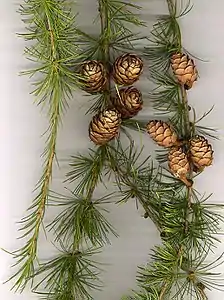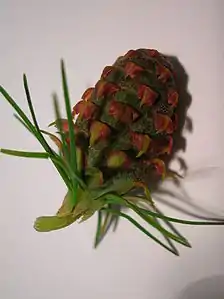Larix decidua
Larix decidua, the European larch, is a species of larch native to the mountains of central Europe, in the Alps and Carpathian Mountains as well as the Pyrenees, with disjunct lowland populations in northern Poland and southern Lithuania. It is widely naturalized in Scandinavia. Its life span has been confirmed to be close to 1000 years [2] (with claims of up to 2000 years) but is more often around 200 years.[3] It is claimed that one of the larches planted by the second Duke of Atholl at Dunkeld in 1738 is still standing.[4]
| Larix decidua European larch | |
|---|---|
_Val_d'Anniviers._Europese_larix_(Larix_decidua)_01.JPG.webp) | |
| European larch in l'A Bran, (1798 m) Val d'Annivier. | |
| Scientific classification | |
| Kingdom: | Plantae |
| Clade: | Tracheophytes |
| Division: | Pinophyta |
| Class: | Pinopsida |
| Order: | Pinales |
| Family: | Pinaceae |
| Genus: | Larix |
| Species: | L. decidua |
| Binomial name | |
| Larix decidua | |
 | |
Distribution:
| |
Description

Larix decidua is a medium-size to large deciduous coniferous tree reaching 25–45 m tall, with a trunk up to 1 m diameter (exceptionally, to 53.8 m tall and 3.5 m diameter). The crown is conic when young, becoming broad with age; the main branches are level to upswept, with the side branches often pendulous. The shoots are dimorphic, with growth divided into long shoots (typically 10–50 cm long) and bearing several buds, and short shoots only 1–2 mm long with only a single bud. The leaves are needle-like, light green, 2–4 cm long which turn bright yellow before they fall in the autumn, leaving the pale yellow-buff shoots bare until the next spring.
The cones are erect, ovoid-conic, 2–6 cm long, with 10-90 erect or slightly incurved (not reflexed) seed scales; they are green variably flushed red when immature, turning brown and opening to release the seeds when mature, 4–6 months after pollination. The old cones commonly remain on the tree for many years, turning dull grey-black.
It is very cold tolerant, able to survive winter temperatures down to at least -50 °C, and is among the tree line trees in the Alps, reaching 2400 m altitude, though most abundant from 1000–2000 m. It only grows on well-drained soils, avoiding waterlogged ground and is not shade tolerant.
Cultivation
It is thought to have been first cultivated in Britain in 1629.[5] John Evelyn encouraged its wider planting and use.[6] Three successive Dukes of Atholl planted it widely[7] and the fourth Duke wrote "Observations on Larch" in 1807 encouraging further its cultivation, which he practiced on a large scale.[8]
European larch is widely cultivated in southern Canada and the northeastern United States. It has been naturalized in Maine, Michigan, New York, Connecticut, New Hampshire, Vermont, and Rhode Island. In the northern Appalachian Mountains it is often used for the reforestation of surface mines.[9] European larch can grow on drier soils and tolerate warmer climates than the native tamarack, being better suited to non-boreal climates.[10]
Subspecies
There are two subspecies:
- Larix decidua subsp. decidua - European larch or Alpine larch. Most of the range, except as below. Cones 2.5–6 cm; shoots yellow-buff.
- Larix decidua subsp. polonica - Polish larch. Disjunct in lowland northern Poland. Cones 2–3 cm; shoots very pale yellow-buff, almost white.
Uses
Larix decidua is cultivated as an ornamental tree for planting in gardens and parks.[11]
- Wood
The wood is tough and durable, but also flexible in thin strips, and is particularly valued for yacht building; wood used for this must be free of knots, and can only be obtained from old trees that were pruned when young to remove side branches.
Small larch poles are widely used for rustic fencing.
- Other
Because of its fast juvenile growth and its pioneer character, larch has found numerous applications in forestry and agroforestry. It is used as a ‘preparatory species’ to afforest open land, abandoned farmland or disturbed land and as a ‘nurse species’ prior to the introduction of more demanding species.[12]
Ecology
The seeds are an important food for some birds, notably siskin, lesser redpoll and citril finch, while the buds and immature cones are eaten by capercaillie.
European larch needles are the only known food for caterpillars of the case-bearer moth Coleophora sibiricella; its cone scales are used as food by the caterpillars of the tortrix moth Cydia illutana.
Invasive species
Larix decidua is classed as a wilding conifer, an invasive species which spreads into the high country of New Zealand. It was planted by the New Zealand Forest Service for erosion control.
Gallery
 Siberian larch in autumn colour.
Siberian larch in autumn colour. Larch emunicipality Albeck, district Feldkirchen, Carinthia / Austria
Larch emunicipality Albeck, district Feldkirchen, Carinthia / Austria Early spring foliage.
Early spring foliage. European larch woodland in summer, Alpes-Maritimes, France.
European larch woodland in summer, Alpes-Maritimes, France. European larch foliage and cones.
European larch foliage and cones. Developing seed cone in detail.
Developing seed cone in detail. Young seed cones (red) and pollen cones (yellow).
Young seed cones (red) and pollen cones (yellow). Young needles and male 'flowers' or strobili.
Young needles and male 'flowers' or strobili. South Tyrol, Wengen-La Val-La Valle
South Tyrol, Wengen-La Val-La Valle Parc régional du Queyras, Embrun, Hautes-Alpes, France
Parc régional du Queyras, Embrun, Hautes-Alpes, France Autumnal forest with larches, spruces and arolla pines at Seebachern
Autumnal forest with larches, spruces and arolla pines at Seebachern European larch planted for erosion control on a scree slope in Canterbury, New Zealand.
European larch planted for erosion control on a scree slope in Canterbury, New Zealand.._Wond_van_een_afgebroken_tak._Europese_larix_(Larix_decidua)_02.jpg.webp) Wound from a broken branch.
Wound from a broken branch. Young female cone
Young female cone Male cones
Male cones Larix decidua var. polonica 1962 accession in fall, Arnold Arboretum of Harvard University.
Larix decidua var. polonica 1962 accession in fall, Arnold Arboretum of Harvard University.
References
- Farjon, A. (2017). "Larix decidua". IUCN Red List of Threatened Species. 2017: e.T42309A83969267. doi:10.2305/IUCN.UK.2017-2.RLTS.T42309A83969267.en.
- "Larix decidua (Europäische Lärche) description - The Gymnosperm Database". www.conifers.org. Retrieved 2017-12-07.
- http://www.plantwise.org/KnowledgeBank/Datasheet.aspx?dsid=29967
- "Archived copy". Archived from the original on 2016-03-04. Retrieved 2016-01-11.CS1 maint: archived copy as title (link)
- Parkinson, Paradisus
- The Gardener's Dictionary, Vol.1, Philip Miller, 1835
- A History of British Forest-trees: Indigenous and Introduced, Prideaux John Selby, 1842
- The Philosophical Magazine and Journal, Vol. 53, 1819
- "Larix decidua". US Forest Service. Retrieved 13 July 2016.
- Perry, Leonard. "Larches Large and Small". University of Vermont Extension. Retrieved 13 July 2016.
- "Larix decidua". Royal Horticultural Society. Retrieved 23 July 2013.
- Matras, Jan; Pâques, Luc E. (2008). "European Larch, Larix decidua: Technical guidelines for genetic conservation and use" (PDF). European Forest Genetic Resources Programme. Cite journal requires
|journal=(help) - D'Cruz, Mark. "Ma-Ke Bonsai Care Guide for Larix decidua". Ma-Ke Bonsai. Archived from the original on 2012-05-14. Retrieved 2011-07-08.
External links
| Wikimedia Commons has media related to Larix decidua. |
- Larix decidua images at the Arnold Arboretum of Harvard University Plant Image Database
- Friedman, William (Ned). "Spring larch pilgrimage."Posts from the Collection, Arnold Arboretum of Harvard University, 17 April 2018. Accessed 6 May 2020.
- Images of Larix decidua (European larch)
- Larix decidua. Information, genetic conservation units and related resources. European Forest Genetic Resources Programme (EUFORGEN)
